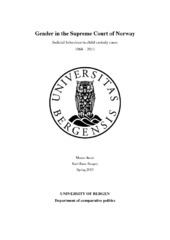| dc.description.abstract | This thesis explores how gender affects the votes of Norwegian Supreme Court judges in cases of disputed child custody in the period from 1968 to 2011. A typology of four common approaches to the study of gendered behaviour is tested. The Different Voice approach assumes that men and women reason in a fundamentally different way. Within the Representative approach, gender groups are perceived as social classes. The Informational approach assumes that the differences between male and female judges are due to information they gain from social interaction throughout life. Finally, the Organisational approach assumes that any initial gender differences are subdued by professional experience. Hypotheses inferred from each theoretical approach are tested by employing multi-level logistic regression analysis. The dependent variable is the individual judge's propensity to vote for the feminine party. The data is organised in a two-level hierarchical model, where factors related to judges and their votes are placed at level 1. Factors related to panel composition or case particularities are placed at level 2. Because this structure does not control for inter-individual dependencies, an important part of the analysis is to identify and control for the effect of critical actors, i.e. judges who vote consistently either in favour or disfavour of the female party. An important methodological conclusion is that this seems to be a prudent manner of controlling for inter-individual dependencies and expose spurious effects. The data consists of 750 votes in 150 child custody cases. This is the entire population of cases between 1968 - the year justice Lilly Bølviken was appointed the first female judge in the Norwegian Supreme Court - and 2011. The analysis shows that female judges are less likely to vote in favour of the feminine party. Gender only explains a fraction of the differences in judges' voting pattern. It is, however, likely to affect judges in their exercise of judicial discretion and in cases of dissent. Both the Informational and Organisational approaches seem ill fit to explain the observed gendered behaviour in these cases. Although both have some weaknesses, both the Different Voice and Representational approaches seem fruitful in this respect. | en_US |
